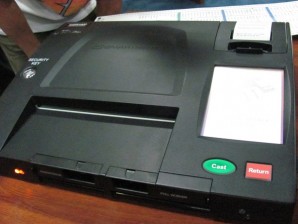Comelec elects to use PCOS, other machines in 2016
MANILA, Philippines–The Commission on Elections (Comelec) has decided to use another voting technology aside from the precinct count optical scan (PCOS) machines in 2016, an agency official told reporters on Monday.
The official, who declined to be identified for lack of authority to speak, said the commission en banc adopted the recommendation of the Comelec Advisory Council (CAC) to use “multiple or mixed technologies” in the elections to accommodate more voters.
“In principle, it has been decided to use mixed technologies. It is not a total adoption but we are basically following the CAC recommendation, although there will be some modifications,” the source said.
Additional technology
He said the PCOS machines would still be the primary automated election system (AES) but another technology will be used as a supplementary system.
“We will still use the PCOS but we will also look for a second technology that will be acquired through public bidding,” he added.
The CAC had proposed the use of either the Optical Mark Reader (OMR), the touch-screen technology called Direct Recording Electronic or Internet voting for Filipinos abroad, on top of the PCOS machines.
“The basic criteria that we will ensure for the second technology is that it should be compatible with our PCOS machines,” said the Comelec insider.
When asked for confirmation, Comelec Chair Sixto Brillantes Jr. said the en banc had arrived at a decision on the AES to be used in the 2016 elections but could not divulge it yet since the commission had yet to formalize it in a resolution.
In its recommendation to the Comelec, the CAC said that while it could reuse the PCOS machines as the primary voting system, it must also seriously consider the use of multiple technologies to “promote interoperability and encourage innovative solutions.”
Insufficient
The CAC said the PCOS machines would not be sufficient to accommodate the entire voting population, which the Comelec expects to reach 56 million when voter registration ends in October next year.
As this developed, the Comelec is considering making available early to public scrutiny the source code of the AES to be used in the 2016 election without waiting for international certification.
“If we are to use the existing AES, there’s already a source code for that, which is already in the central bank. We can just open it for review early,” Brillantes told reporters.
The source code is the computer program that runs the PCOS machines.
RELATED STORY
Comelec wants early public scrutiny of source code for automated polls
